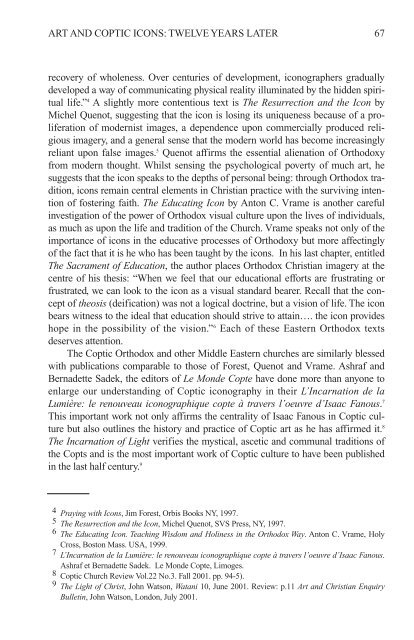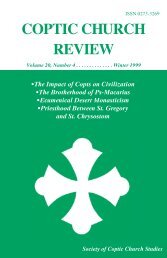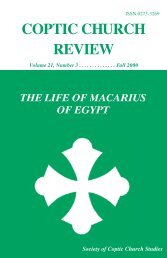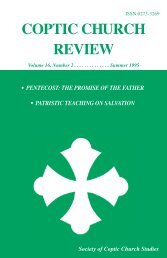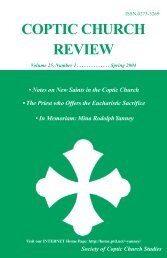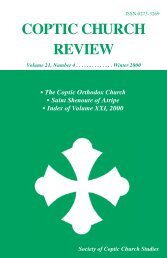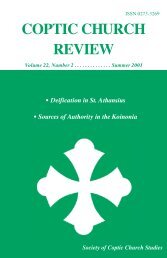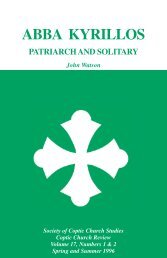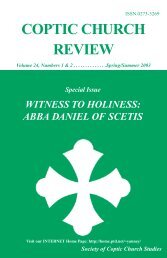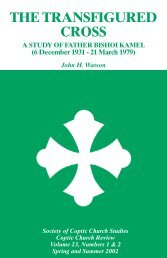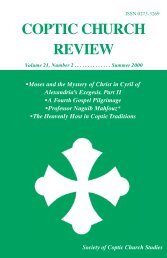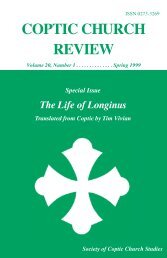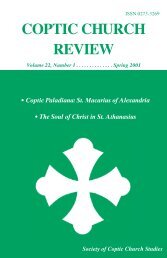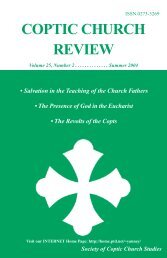2004 Fall.Vol25.#3.pdf - Coptic Church Review
2004 Fall.Vol25.#3.pdf - Coptic Church Review
2004 Fall.Vol25.#3.pdf - Coptic Church Review
Create successful ePaper yourself
Turn your PDF publications into a flip-book with our unique Google optimized e-Paper software.
ART AND COPTIC ICONS: TWELVE YEARS LATER 67<br />
recovery of wholeness. Over centuries of development, iconographers gradually<br />
developed a way of communicating physical reality illuminated by the hidden spiritual<br />
life.” 4 A slightly more contentious text is The Resurrection and the Icon by<br />
Michel Quenot, suggesting that the icon is losing its uniqueness because of a proliferation<br />
of modernist images, a dependence upon commercially produced religious<br />
imagery, and a general sense that the modern world has become increasingly<br />
reliant upon false images. 5 Quenot affirms the essential alienation of Orthodoxy<br />
from modern thought. Whilst sensing the psychological poverty of much art, he<br />
suggests that the icon speaks to the depths of personal being: through Orthodox tradition,<br />
icons remain central elements in Christian practice with the surviving intention<br />
of fostering faith. The Educating Icon by Anton C. Vrame is another careful<br />
investigation of the power of Orthodox visual culture upon the lives of individuals,<br />
as much as upon the life and tradition of the <strong>Church</strong>. Vrame speaks not only of the<br />
importance of icons in the educative processes of Orthodoxy but more affectingly<br />
of the fact that it is he who has been taught by the icons. In his last chapter, entitled<br />
The Sacrament of Education, the author places Orthodox Christian imagery at the<br />
centre of his thesis: “When we feel that our educational efforts are frustrating or<br />
frustrated, we can look to the icon as a visual standard bearer. Recall that the concept<br />
of theosis (deification) was not a logical doctrine, but a vision of life. The icon<br />
bears witness to the ideal that education should strive to attain…. the icon provides<br />
hope in the possibility of the vision.” 6 Each of these Eastern Orthodox texts<br />
deserves attention.<br />
The <strong>Coptic</strong> Orthodox and other Middle Eastern churches are similarly blessed<br />
with publications comparable to those of Forest, Quenot and Vrame. Ashraf and<br />
Bernadette Sadek, the editors of Le Monde Copte have done more than anyone to<br />
enlarge our understanding of <strong>Coptic</strong> iconography in their L’Incarnation de la<br />
Lumière: le renouveau iconographique copte à travers l’oeuvre d’Isaac Fanous. 7<br />
This important work not only affirms the centrality of Isaac Fanous in <strong>Coptic</strong> culture<br />
but also outlines the history and practice of <strong>Coptic</strong> art as he has affirmed it. 8<br />
The Incarnation of Light verifies the mystical, ascetic and communal traditions of<br />
the Copts and is the most important work of <strong>Coptic</strong> culture to have been published<br />
in the last half century. 9<br />
4 Praying with Icons, Jim Forest, Orbis Books NY, 1997.<br />
5 The Resurrection and the Icon, Michel Quenot, SVS Press, NY, 1997.<br />
6 The Educating Icon. Teaching Wisdom and Holiness in the Orthodox Way. Anton C. Vrame, Holy<br />
Cross, Boston Mass. USA, 1999.<br />
7 L’Incarnation de la Lumière: le renouveau iconographique copte à travers l’oeuvre d’Isaac Fanous.<br />
Ashraf et Bernadette Sadek. Le Monde Copte, Limoges.<br />
8 <strong>Coptic</strong> <strong>Church</strong> <strong>Review</strong> Vol.22 No.3. <strong>Fall</strong> 2001. pp. 94-5).<br />
9 The Light of Christ, John Watson, Watani 10, June 2001. <strong>Review</strong>: p.11 Art and Christian Enquiry<br />
Bulletin, John Watson, London, July 2001.


